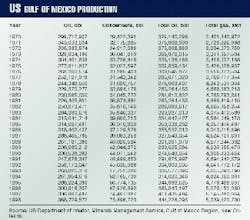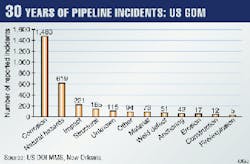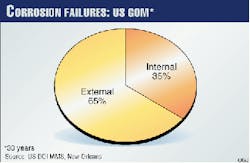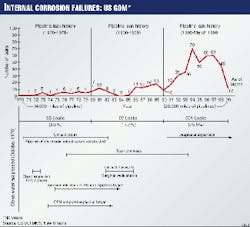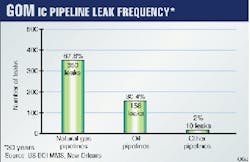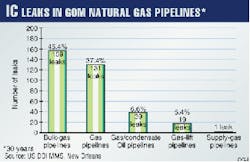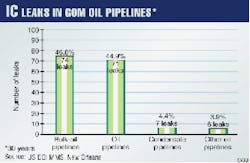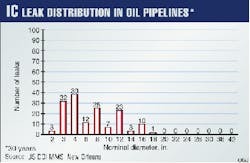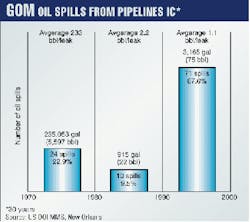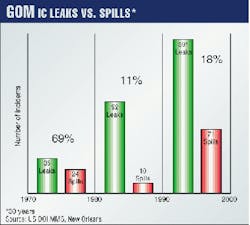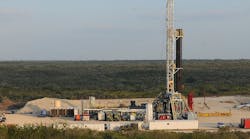Internal corrosion increasingly threatens aging oil and gas pipelines operating in the US Gulf of Mexico (GOM). That's the major conclusion of a review of US Department of Interior Minerals Management Service (DOI/MMS) pipeline leak statistics.
The comprehensive study of GOM offshore oil and gas pipeline failures caused by internal corrosion used internal pipeline-failure statistics compiled from 30 years of pipeline-industry reporting to the MMS.
Leaks or ruptures must be reported whenever they involve property or environmental damage, bodily injury, or exposure to claims by others.
Through a grant from the US Department of Energy (DOE), the University of Louisiana at Lafayette's Corrosion Research Center is developing a computer model to predict corrosion rates in offshore pipelines.
Predictive computer modeling should aid researchers and pipeline companies in understanding and prioritizing the detrimental effects of shallow and deepwater internal-corrosion mechanisms.
It should also assist in developing offshore pipeline design and mitigation technologies for internal corrosion, while simultaneously helping to educate the offshore workforce in prudent operation of facilities.
Rapid expansion
Most of the GOM offshore pipeline system has been constructed over the past 30 years. The region, with its more than 28,000 miles of pipelines that transport oil and natural gas to shoreline plants, is an essential source of US energy.
GOM production is approximately 1 million b/d of crude oil and 14 bcfd of natural gas. At present, the offshore region produces 22% of US oil and 27% of US gas consumed daily.1
Table 1 presents a 29-year compilation of oil and gas production for the entire Gulf of Mexico.
The offshore pipeline infrastructure is expanding rapidly to keep up with deepwater production. In 1991, there were approximately 20,000 miles of pipelines in the GOM approved by the MMS.2 From 1995 to 1998, the MMS approved 5,747 miles of pipeline for construction, with 1,627 miles approved in 1997, a new record.1
Loss of reliability of offshore energy-supplying pipelines could cripple the US; replacement of the offshore pipeline infrastructure would be prohibitively expensive.
The growth of pipelines and pipelining technology to pursue the deepwater expansion into the 21st Century gives added value to older existing pipelines that will be tied into and must carry the prolific deepwater production.
Offshore pipelines, from the South Padre Island area (Texas) to the Pensacola/Destin Dome area (Florida), provide an efficient, cost-effective, and environmentally safe means for transporting hydrocarbons from the wellheads to the shoreline plants. Once ashore, the oil and gas are dehydrated and refined, then transported to the end user.
But the integrity of older, low-flow pipelines is often questioned.
Offshore pipelines often carry multi-phase flow because of federal regulations and economics. The flow may contain varying amounts of such entrained, corrosive, harmful contaminants as produced water, H2S, CO2, O2 (trace), salt, sand, corrosion, nondisposable downhole products, and bacteria along with salable products.
The detrimental effects of these corrosive contaminants are evident in pipeline-leak frequencies.
Regulations
In 1968, to ensure pipeline integrity, the US Department of Transportation's Research & Special Projects Administration (RSPA) promulgated pipeline safety regulations for oil and natural gas transmission, and the MMS issued similar regulations for oil and gas production and field pipelines.3 4
These regulations define the minimum criteria for the design, construction, testing, and safe operation of pipelines. In addition, industry professional organizations have developed many of the standards, specifications, and recommended practices for corrosion control that form a major portion of these regulations.5
Federal regulations require each offshore pipeline operator to be responsible for maintaining an emergency-procedure plan that outlines necessary actions to be administered during an offshore emergency.3
Provisions in the plan require that DOT-jurisdictional pipeline companies, as prudent operators, report pipeline accidents that involve injuries, fatalities, property damage in excess of $50,000, environmental pollution, unintentional release of product, customer outages, or any incident that, in the opinion of the operator, could affect the integrity of the pipeline.
MMS is the designated federal agency with jurisdiction for receiving reports of all offshore accidents and maintaining an active master database of reporting. The MMS requires that all (DOT and DOI) offshore incidents and incident repairs be reported to their agency, regardless of cost.
Corrosion of pipelines represents the largest number of reported offshore leak incidents (1,483) of any of the tracked categories over the past 30 years (Fig. 1).
Chemical reaction
Internal corrosion (IC), an important form of offshore pipeline corrosion, usually results from a chemical reaction between the pipe and the corrosive components in the product stream.
For corrosion to occur, there must be free water (electrolyte) present in the pipeline. Free water can be introduced into the line from production sources, hydrostatic testing, pipeline failures and repairs, condensation resulting from temperature and pressure changes in pipe, and other sources.
Increased salt concentrations and pH changes in the water, along with other factors, have been known to accelerate corrosion.
The product, before it enters the pipeline, is specified by contract to be dewatered (1% maximum bottoms sediment and water-bs&w) and within certain quality standards for measurement purposes and to minimize internal corrosion.
In-service system upsets often allow significant amounts of moisture and other corrosive production carry-over contaminants to accumulate locally in the pipe over time.
The primary method of IC attack of pipeline steel (API 5LX) is in the form of localized pinhole pitting near the bottom (6 o'clock position) of the pipe where water accumulates. Sags and low areas of piping have been found to collect water and corrosive contaminants that stagnate and harbor harmful bacteria.
The bacteria may, along with other factors, contribute to under-deposit corrosion. Under-deposit corrosion has been found to be most prevalent offshore in low-flow bulk gas and bulk oil gathering lines.
Offshore internal corrosion has been found to occur more frequently in gathering than in transmission lines. Some reasons for the increased failure in gathering lines can be their close proximity to production, intermittent flow rates, and that most are not piggable, or if piggable, not pigged regularly.
One of the biggest problems pertaining to IC in pipelines is the absence of accurate data on failure modes and failure rates.
Additional research is needed to develop better offshore pipeline system reliability tools:
- To investigate failure rates and modes.
- To understand the optimum operation and maintenance levels for offshore pipeline systems
- To locate and assess design, material, and construction defects
- To specify environmental design criteria.
- To establish target risk levels that account for modeling uncertainties and damage-tolerance measures.
IC trends
There are numerous offshore pipeline leak or rupture incidence categories.
One category, tracked by the MMS in the Gulf of Mexico, is the incidence of pipeline failure caused by internal corrosion. Approximately 35% of offshore corrosion incidents reported to the MMS result from internal corrosion (Fig. 2).
Trending of offshore IC incidents in pipelines over the past 30 years, however, shows a significant increase in incidence within the last 10 years, as pipelines age, operating conditions change, and pipeline mileage increases (Fig. 3).
The first 10-year period (1970-1980), with the passage and enforcement of the Clean Water Act (1970) that introduced water into offshore pipelines, reported 35 pipeline leaks due to IC (6.8% of the total 30 year IC leak count).
The second 10-year period (1980-1990) recorded 92 IC leaks (17.7%).
The third 10-year period registered 391 IC leaks (75.5%). Many were found to have reccurred in the same pipeline but at different times.
The trend indicates that as the offshore pipeline infrastructure grows, ages, and continues to operate under harsh product-quality conditions, pipeline IC failures are likely to continue to increase.
Offshore IC pipeline leaks are often more prevalent downstream of producing gas wells that exhibit internal corrosion problems in production equipment and downhole tubing strings.
Under "normal" offshore operating conditions, statistics indicate that most offshore pipelines do not report internal corrosion leaks in the first 10 years of operational life. One reason for reduced failures in new pipe is the often designed-in corrosion allowance (6-10 mm maximum based on corrositivity, inspection plans, pipeline criticality, and consequences of failure).6
Currently, pipelines that were designed for 20-year life or less, with deepwater production expansion, may be expected to operate beyond their original design lives. Many older and once profitable short-life pipelines may have to be rehabilitated, retired, or re-laid because of internal corrosion.
The increase in IC leak reports over the last 10 years raises a red flag about such pipeline-industry issues as ensuring future pipeline reliability, safety, and integrity. This leak trend increase may be attributed to several factors:
- Development of new fields with harsher operational pipeline conditions.
- New production infusion into older inactive or low-flow pipelines.
- Increasing tendency for unseparated fluids to be transported as multiphase mixtures of oil, gas, and water.
- Changes in regulations.
- Major oil and gas companies selling older "marginal producing" facilities to smaller, untrained independent operators.
- Changes in companies' philosophies (restrictions in a company's operation and maintenance budgets because of product price fluctuations).
With product spills resulting from leaks threatening the delicate marine environment, enforcement of existing safety regulations to maintain pipeline integrity in the Gulf of Mexico is increasing.
IC mitigation
Some relied-upon methods of offshore internal-corrosion control include dehydration, gas-quality enforcement, on-stream pigging, corrosion inhibition, corrosion monitoring, material selection (corrosion-resistant alloys, etc.), internal coating (fusion-bonded epoxy, efficiency, in situ), biocide treatment, vessel-tank clean-out, sweeping, product flow blending, and pipeline system optimization operation.
Although each method is effective to some extent in controlling internal corrosion, combinations increase control effectiveness. Pigging, corrosion inhibition, and corrosion monitoring are economical maintenance measures routinely used in offshore pipelines.
The Pipeline Safety Reauthorization Act of 1991 required that intelligent pigs be run in pipelines in environmentally sensitive areas.7 If offshore is placed in this category and intelligent pigs are required, problems may arise.
Such problems operating companies may encounter when running geometry or intelligent pigs in offshore pipelines include the following:
- Inaccurate instrument calibration to equate geometry of flaws to wall loss (no calibration digs).
- Pig launcher or receiver lengths too short (limited space on offshore platforms).
- Wet gas.
- Pipeline cleanliness.
- Weather delays.
- Inadequate control of run volumes and pressures (run speed problems).
- Lack of knowledge of facilities.
- Water depths (elevations and geography).
- Pipe bend radii variations (design problems).
- Long line lengths (deep water).
- Subsea tie-ins.
- Valves (full-open, gate, plug, check, remote subsea valves).
- Varying line diameters, dents, and buckles.
- Costs to transport and run.
- Corrosion anomalies difficult to locate, evaluate, and expensive to repair (boats, divers, ROVs).
Statistical analysis
Records show that approximately 518 oil and gas offshore pipeline leaks (35% of corrosion reports) caused by internal corrosion were reported by industry to the MMS from 1970 to early 1999.8
Additionally, the research revealed the following:
- No offshore fatalities have been reported as a result of internal corrosion-induced pipeline leaks and ruptures.
- Only four offshore pipeline ruptures due to IC have been reported during this period.
- There were 477 leaks (92%) caused by pinhole pitting. Nearly all of the pinhole leaks were reported near the bottom (6 o'clock position) of the pipe's ID.
- Seven IC leaks were the result of internal erosion corrosion (high flow rates).
- Approximately 81 IC leaks (16%) occurred in riser piping.
- The remaining 437 IC leaks (84%) occurred in remote portions of subsea pipelines.
- Six pipeline cracks resulted from internal corrosion.
- MMS reports indicated that 23 pipeline leaks were classified as being caused by internal corrosion of unknown distinction.
The first offshore pipeline leak due to any cause (that is, outside forces, external or internal corrosion, material defects, construction defects, and other) was reported to the MMS on Oct. 17, 1967.
The first offshore pipeline leak due to IC was reported to the MMS on Feb. 2, 1970. The last offshore IC leak reported with the current data was on Mar. 3, 1999.
Leak frequency
According to MMS reports, the average frequencies of leaks for the GOM offshore pipeline industry over the past 30 years were 17.30 leaks/year and 1.44 leaks/month.
A further breakdown of pipeline IC leak statistics over the last 30 years indicates that, of the 518 leaks reported, 350 leaks (67.6%) occurred in natural gas pipelines, while 158 leaks (30.4%) occurred in oil pipelines, and 10 leaks (2%) occurred in other pipelines (Fig. 4).
This leak distribution seems understandable because it is believed that some oils transported through pipelines have been known to exhibit corrosion inhibitive properties that could prevent IC leaks.
Offshore natural gas pipelines that have experienced reported IC leaks can be divided into five categories:
- Bulk gas (primarily small-diameter field pipelines and flow lines with three-phase flow).
- Gas (usually larger diameter natural gas pipelines with one or two-phase flow).
- Gas-condensate-oil (two-phase flow pipelines).
- Gas lift (small diameter in-field lines, usually containing dry gas from the separator, and used to provide gas supply or gas lift)
- Supply gas (small diameter-usually dry gas from separator, used to operate pumps and other equipment).
Bulk-gas pipelines have experienced the greatest number of internal corrosion leaks (159 leaks, 45.4%) in the natural gas-pipeline category. Gas pipelines had 131 IC leaks (37.4%); gas-oil-condensate pipelines 39 IC leaks (6.6%); gas-lift pipelines 19 IC leaks (5.4%); supply-gas lines 1 IC leak (Fig. 5).
In the past, bulk-gas pipelines have usually transported the poorest quality gas and have required the greatest amount of pigging and corrosion inhibition to maintain their integrity.
Offshore oil pipelines can be classified into four categories as follows:
- Bulk oil (primarily unprocessed, heavy black oil pipelines with some condensate and water).
- Oil (usually pipelines transporting some processed black oil).
- Condensate (light oil carrying pipelines with product usually from gas wells).
- Other (service and auxiliary pipelines to pumps and other facilities in a field).
As shown in (Fig. 6), bulk-oil pipelines reported 74 internal corrosion leaks (46.8%); oil pipelines 71 IC leaks (44.9%); condensate lines 7 leaks (4.4%); and other oil lines 6 IC leaks (3.9%).
A major contributor to oil-pipeline leaks is microbiologically influenced corrosion (MIC). Water and other production contaminants entrained in the oil fall out of the product stream and settle to the bottom of the pipe, usually in sags or low areas. Pitting corrosion is the normal corrosion mechanism that causes leaks in this piping.
Another statistical 30-year study was undertaken with MMS reports to identify leak frequency in offshore oil and gas pipelines with varying nominal diameters.7
Reports showed that natural gas pipelines were more susceptible to IC. The progression of leaks by nominal diameter was 3 in. (80 leaks), 12 in. (62 leaks), 4 in. (46 leaks), 16 in. (45 leaks), and 6 in. (38 leaks; Fig. 7).
Offshore oil pipelines reported fewer failures and had the following IC leak frequencies by nominal diameter: 4 in. (39 leaks), 3 in. 32 leaks), 8 in. (25 leaks), 12 in. (23 leaks), 6 in. (12 leaks), 16 in. (10 leaks; Fig. 8).
From pipeline-operating histories, it is evident that flow conditions and other factors also contributed to these leak frequencies.
Pipeline spills; risk
MMS data for the Gulf of Mexico from 1970 through March of 1999 (Fig. 9) reported that there were 105 oil spills that resulted from internal-corrosion failures in pipelines.8
The pipeline oil-condensate spilled during this period because of internal corrosion leaks totaled 239,134 gal (5,693.7 bbl). The calculated average oil-condensate spilled per leak was 2,277.5 gal (54.2 bbl).
This statistic is deceiving, however, because one of the oil spills (16-in. OD, two-phase-flow gas pipeline IC crack in 1973) accounted for 88% (5,000 bbl) of the 30-year total oil spilled.
As shown in Fig. 10, from 1970 through 1979, 24 IC pipeline spills (22.9%) and 235,053.3 gal (5,596.5 bbl and 98.3%) of oil-condensate were spilled averaging 9,793.9 gal (233 bbl)/leak.
In the 10 years from 1980 through 1989, 10 spills (9.5%) and 915.2 gal (21.8 bbl; 0.38%) of oil-condensate were spilled averaging 91.5 gal (2.2 bbl)/leak. And from 1990 through March 1999, 71 spills (67.6%) and 3,165.5 gal (75.4 bbl; 1.3%) of oil-condensate were spilled averaging 44.6 gal (1.1 bbl)/leak.
The current trend indicates that both the number of internal corrosion pipeline leaks and the volumes of oil reported spilled because of the number of leaks are increasing. The volume of oil spilled per leak, however, has decreased within the last 10 years.
These facts, coupled with the expansion and aging of offshore pipelines, further indicate the need for improved pipeline technology and operator training to predict when offshore pipe will fail and where companies should prioritize internal-corrosion mitigation measures.
The question of how soon the aging pipeline infrastructure will fail due to incessant internal corrosion attack in the offshore Gulf of Mexico must be addressed.
The University of Louisiana at Lafayette's Corrosion Research Center, on the US Gulf Coast, has recently been awarded a $500,000, 3-year research grant under DOE's Energy and Environmental Technology Applications Program (EETAP) to investigate internal pipeline corrosion.
This center has produced computer software that has become the industry standard for estimating the tubing life of gas-condensate wells.9 10 Faculty of the chemical engineering and chemistry departments, along with representatives from industry, regulatory agencies, and research organizations, have formed a consortium for the development of a pipeline computer model that will accurately assess the time-to-failure based on fundamental corrosion knowledge.
The research will also investigate the effectiveness of measures that can be undertaken to maintain pipeline safety, integrity, and the prevention of environmental liabilities (spills).
References
- Alvarado, A., "Gulf of Mexico Pipeline Failures and Regulatory Issues," presentation at the University of Louisiana at Lafayette, 1st Meeting Internal Pipeline Corrosion Consortium (EETAP), Lafayette, La., May 27, 1999.
- Pearcy, R., "Perspectives on Offshore Pipeline Operations," International Workshop on Offshore Pipeline Safety, New Orleans, Dec. 4-6, 1991.
- DOT/RSPA/OPS (1998) "Pipeline Safety Regulations" (October, 1998), Code of Federal Regulations, Title 49, Chapter 1, Subchapter D, Parts 190, 191, 192, 193, 194, and 195, (Subpart I).
- DOI/MMS (1998), "Minerals Management Service Offshore (O&G) Regulations" (July 1998), CFR Title 30, Part 250, Subpart J.
- NACE International "Book of Standards," Vols. 1 & 2, Houston, October 1998.
- Kapusta, S.D., Pots, B.F.M., and Connell, R.A., "Corrosion Management of Wet Gas Pipelines," NACE CORROSION/99, Apr. 25-30, 1999.
- HR1489, "The Pipeline Safety Act of 1991," S1583 "The Pipeline Safety Improvement Act of 1991," National Library of Congress, Washington, 1991.
- Department of the Interior, Minerals Management Service, "Master Database of Offshore Pipeline Reportable Leaks," New Orleans, 1967-1999.
- Fang, C.S., Garber, J.D., Perkins, R.S., and Reinhardt, J.R., "Computer Model of a Gas Condensate Well Containing CO2," NACE CORROSION/89, Apr. 17-21, 1989.
- Farshad, F., Garber, J.D., Polaki, V., "A Comprehensive Model for Predicting Corrosion Rates in Gas Wells Containing CO2," 1998 SPE Gas Technology Symposium, Mar. 15-18, 1998, Calgary.
The Authors
James D. Garber is professor and head of the department of chemical engineering and director of the ULL Corrosion Research Center at the University of Louisiana at Lafayette. Garber is a registered professional engineer in Louisiana. He holds a bachelors in chemical engineering from the University of Southwestern Louisiana, Lafayette, and a PhD from Georgia Tech, Atlanta.
Alex Alvarado has worked for the MMS for more than 20 years in different positions including the present position as chief of the pipeline section for MMS' Gulf of Mexico regional office. Alvarado earned a bachelors in electrical engineering from the University of Texas-Arlington.
Robert H. Winters is a corrosion control consultant at TechniKos Inc., Broussard, La. He has also been employed by El Paso Energy (Tenneco Energy and Tennessee Gas Pipeline) in corrosion engineering for more than 20 years. He was the internal corrosion specialist for Tennessee Gas. Winters earned BS and MS degrees in microbiology and chemistry from the University of Southwestern Louisiana.

